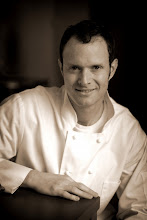Caramel, just the word can make your mouth water. But making caramel can be a bit more daunting. Caramel adheres to Malcolm Gladwell's meme of a tipping point. You want to heat the sugar until it just caramelizes, but not so much that it tips and burns. That's it - in essence. In practice everyone has their system.
Here at HGC we make a caramel pot de creme that is, in a word, fantabulous. But how to make it, ah, that is the question. The first few times I tackled / was forced at gunpoint to make the caramel there was no end to the advice given.
"Don't stir it with a spoon. Swirl it by moving the pan."
"Don't swirl it, you'll get too much up on the sides of the pan."
"Whatever you do, don't scrape down the sides of the pan."
"Scrape down the sides of the pan with a wet pastry brush."
"Use low heat and bring it up slowly."
"Crank the heat and blast it."
The one thing I was sure of was that I wanted to use a candy thermometer. At 250 degrees it would be ready.
The one thing everyone agreed on saying to me was "What are you doing with that thermometer?"
Not only does caramel have a very fine tipping point but I was supposed to know where it was by feel, by sight, by smell, by sheer primal cooking instinct. That's how it goes sometimes in a professional kitchen, you make your bones by being so immersed in the context of your food you just know.
Needless to say my first attempt ended in a dark brown melted disaster. That was two years ago. I am still trying to clean the pan.
The next time our pastry chef extraordinaire David came over. He watched me watching the light gold bubbles rising and popping. Then, at the critical moment, he shoved me into the wall and took over. With a towel in his hand he grabbed the handle of the pan and shook it and swirled it and tilted it to get a look at what was going on at the bottom. The man had no fear. He spun it around. He smelled it. He gave it a good long squint.
He was moving with the flow of the sugar. In technical terms it moved from soft ball to hard ball to hard crack. But we were experiencing it from light brown into deep golden brown, from a light sweetness to a rich sweetness. With one last look David pulled the pot from the stove.
There, at the bottom, was a beautiful golden caramel. David had me pour in the cream. It foamed and roared then settled down. Now we had ourselves a caramel sauce. I added some milk and then we tempered in the eggs and we just like that we had moved our way to our pot de cremes.
You can't really learn to make caramel. You have to live it.
Subscribe to:
Post Comments (Atom)



No comments:
Post a Comment